|

The
Lowdown on Lodi
Or: Why
Wily Wine Lovers Drink Lodi
Let's
start off with a few blanket statements: If your perception of wines
from Lodi, California, is one of strictly bland, watery, sun-raisined
vintages, then you're a damned fool. If you're paying $30 to $60
for the latest blockbuster Zinfandel, Syrah, Viognier or Petite
Sirah from Napa, Sonoma, or any of those newfangled coastal regions
like Paso Robles and Santa Barbara, then you're a double-damned
fool. Lodi is turning out top--quality wines for half the price
of other appellations; and in some cases, wines even more powerfully
packed than just about anything in Schwarzeneggerland.
I've been learning all this the hard way myself. Most memorably,
a few years ago, I was one of about 60 judges at Jerry Mead's annual
New World International Wine Competition, where we tasted a Syrah
that was so good, so phenomenally intense and proportional, that
we all had to vote it "Best Wine" (period!) in the entire
Western World. What could we say, after all the wines were unveiled,
when we found out that this Syrah was grown and vinified in Lodi
by Delicato Family Vineyards and sold for a ridiculous $8 a bottle
across the country?
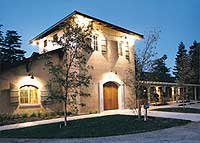 |
| Find
out why wily wine lovers drink Lodi at the Wine & Visitor
Center |
Lodi,
the region cursed in a Creedence Clearwater Revival song, is where
the Mondavi family set up a factory to churn out their lower range
"Woodbridge" line. Despite these dubious distinctions,
Lodi is a great place to be stuck these days. Especially if you
book a stay at the Wine
& Roses Hotel, which reeks of wine country taste and romance;
and visit the Lodi Winegrape Commission's incredible Wine
& Visitor Center, where they'll spell out for you all the
reasons why the wily wine lover drinks Lodi, while letting you taste
at least a dozen of Lodi's best for further, irrefutable proof.
Of course, it wasn't always this way. While less than a 90 minute
drive east of Napa Valley and the Bay Area, and the longtime cradle
of something like twenty percent of California's wine grapes (including
forty percent of the state's Zinfandel crop), the region between
Stockton and Sacramento was home to only half a dozen wineries ten
years ago. Apart from the plump tomatoes and heavenly, crusty apple
pies found at the Phillips Farms Fruit Stand on Hwy. 12, visitors
had few incentives to find Lodi.
Five years ago the number of Lodi wineries grew to 25, and today
it's up to 50. The beauty of this is that out of those 50 wineries,
at least 40 of them are owned and operated by the same families
who have been growing grapes there since the 1880s. It's rare enough,
these days in California, to be able to walk into a strange winery,
sidle up to the bar and shoot the breeze with a winery owner or
winemaker (as opposed to an hourly employee) over a complimentary
glass or two, but that's not what gets a jaded wine palate like
mine going.
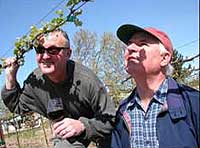 |
David
and Michael inspecting new shoot growth in a block of Viognier. |
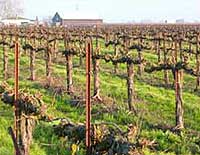 |
Their
Cabernet Sauvignon vineyard block |
It's
when that winemaker or winery owner warms up to you (or in the case
of Mike Phillips—who runs the old family fruit stand as well
as Michael-David
Vineyards—after you try a slice of his apple pie) and
then starts opening his rarest wines, made from pre-World War Two
vineyards, planted on their own roots in the fashion of pre-phylloxera
viticulture. Few connoisseurs of California wine are aware of this
treasure within their midst: some 5,000-plus acres of original rooted
vines sprinkled across Lodi's sandy loams, undoubtedly representing
the largest stand of ungrafted vitis vinifera in the world.
Lodi's
deep, perfectly drained, sandy soil is an inhospitable environment
for the infamous phylloxera louse. The important thing, however,
is the kind of wines that these ancient, gnarly trunked, largely
dry-farmed, head pruned bushes produce: Zinfandels as black as night,
Syrahs in purple raiment, and essence-of-blueberry Petite Sirahs,
all wrapped up in wonderfully round, smooth tannins. In the case
of young and old vines, the Lodi soils seem to drain all semblance
of bitterness and astringency associated with big tannin, high-octane
wines. Lodi's reds may not smack you upside the head like a Napa
Valley Cabernet, or even a well-heeled Côte Rôtie; but
what's wrong with just plain deliciousness?
The Lodi Winegrape
Commission is made up of about 750 independent growers. To raise
the consciousness of both consumers and the rest of the California
production industry as to the intrinsic quality of Lodi vineyards,
they recently invited twelve judges (including myself, a handful
of Master Sommeliers, professional wine educators and industry consultants)
to taste through 60 Lodi grown wines, then pick 12 that best represent
the "Mediterranean" style of wine that the region naturally
seems to give.
Although in many respects Lodi is known mostly for its Zinfandel—a
varietal scientists of the vine now believe originated in Croatia—it
was decided not to include Zinfandel in this selection process since
to the rest of the world the grape is identified more with California
than, say, Spain, Portugal, Southern France, Italy, or other Mediterranean
countries.
As a result of our double-blind tasting, we selected the
following wines:
Renwood:
Viognier "Select Series" 2002—Lodi,
$12
Michael-David Vineyards: "Incognito"
Viognier 2003—Lodi, $18
Clay Station Vineyards: Viognier 2003—Lodi,
$16
Fenestra Winery: Alvarelhao 2002—Lodi,
$15
Bokisch Vineyards: Graciano 2002—Lodi,
$19
Michael-David Vineyards: "Incognito"
Red Blend 2002—Lodi, $18
Grands Amis: Carignane 2002—Lodi,
$18
Jessie's Grove: Carignane 2001—Lodi,
$15
Cosentino: "The Temp" Tempranillo
2002—Lodi, $18
Clay Station Vineyards: Shiraz 2002—Lodi,
$13
Van Ruiten Family Vineyards: Petite Sirah
2002—Lodi, $18
Mettler Family Vineyards: Petite Sirah
2002—Lodi, $22 |
To
give you a more complete idea of the outstanding work being done
in Lodi, here are some of my own notes, taken by grape by grape:
PETITE
SIRAH – There are several things about Petite Sirah
that make little sense. For one, despite its moniker, it is not
the same grape as the true Syrah from France’s Rhone Valley,
although up until the mid-1980s California vintners could barely
tell the difference between Syrah and Petite Sirah in their fields
and wineries.
Secondly, it is only recently that plant geneticists have been able
to establish conclusively that Petite Sirah is identical to a near
extinct French grape called Durif—a cross between Syrah and
a variety called Peloursin, created sometime in the 1880s by a Dr.
Francois Durif. The fact that Californians were already cultivating
something called "Petite Sirah" in the 1880s is further
indication of the historically loose definition of the grape.
Petite Sirah, by virtue of its Syrah parentage, can still be thought
of as a Mediterranean variety. But this association is somewhat
dubious given that:
• Durif was never really established in Southern France, or
any other part of it;
• Petite Sirah is as much Mediterranean as Pinotage (a cross
between Pinot Noir and Cinsaut) is Burgundian and Ruby Cabernet
(Carignan crossed with Cabernet Sauvignon) is Bordelaise—which
they ain’t.
From the perspective of taste, however, Petite Sirah yields full,
four-squared, densely textured, sweetly berried red wines similar
to that of Syrah; which is why it was (and still is, to some extent)
commonly field-mixed and blended with Syrah and even more so with
Zinfandel (the other is/is-not Mediterranean varietal). On more
minute sensory levels, Petite Sirahs tend to be blacker, coarser,
with distinct peppercorn and blueberry-like aromatics; whereas Syrahs
are finer textured, more floral in a violet sense, with roasted
meat or incense-like spices. Otherwise, they are similar.
Meanwhile, back to Lodi: I'm inclined to say that the singularly
most impressive wine coming out of the region today is Petite Sirah.
The good news is that bolstered by their recent successes, Lodi's
family wineries are starting to produce more. The bad news is only
a few plantings of the grape remain. As the older vines naturally
decrease in production, the costs make it harder and harder for
growers to justify keeping them in the ground. All this makes someone
like me want to cry, especially after tasting the likes of the 2002
Michael-David "Earthquake" Petite Sirah ($28); the 2002
Van Ruiten Family Petite Sirah ($18) , the 2001 Mettler Family Petite
Sirah ($22) the 2002 Clay Station Petite Sirah ($16) and the 2002
Jewel Collection California Petite Sirah ($10).
ZINFANDEL – Despite the word out on the street, Lodi's Sacramento
Delta influenced climate and consistency of well drained soils are
closer to the moderately warm coastal regions of California than
to the desert-like conditions of the Central Valley. So while the
typical ultra-premium style of Lodi Zinfandel easily tops 15% alcohol,
it's rarely overripe or raisined, and soft and nimble as opposed
to hot and heavy. Case in point: the 2001 Jessie's Grove "West
Wind" Zinfandel ($18), vinified from 66 year old vines, and
letting out a full throttle of smoky oaked, chocolaty, raspberry-rich
aromas, and a steely core of tannin overlain with thick, fleshy
fruit flavors.
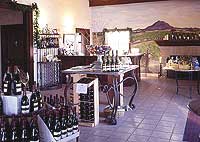 |
| Van
Ruiten Tasting Room |
My
nomination for the best Zinfandel value in Lodi is Michael and David
Phillips' 2002 Windmill Estate Old Vine Zinfandel ($10), which whips
up cinnamon-sugared berry aromas, rounded tannins and quantities
of fresh, lively, zesty fruit flavors, belying its full sized (15%)
demeanor. My nomination for "most decadent" is the 2002
Van Ruiten Family
Winery "Late Harvest" Zinfandel ($20/half bottle),
which fairly scrapes the sky with mildly sweet (3% residual sugar)
black cherry and raspberry intensities, piled atop a densely layered
17.2% natural alcohol content, with absolutely no harsh feel at
all. Although you can think of the latter as something of a mini-Port,
the winery recommends it with smoked pork (better yet, luau pit
roasted pig) or chocolate-raspberry tarts. I'm game!
|
| "Earthquake"
Petite Sirah |
SYRAH
– Lodi now crushes almost three times more Syrah
than Napa and Sonoma combined; yet if there's anything Lodi's wineries
do that's grossly underrated, it's Syrah. To wit: the impenetrably
colored, vividly smoked and lusciously full, long, juicy 2002 Rosenblum
Cellars "Abba Vineyard" Syrah ($18), which I can't see
taking a back seat to anything – French, American or Australian
– in respect to dramatic scale and sheer, joyous intensity
of fruit.
Delicato Family Vineyards now puts out an upper tier of gravelly
hillside sourced (at the eastern edge of Lodi) wines going by a
brand they call Clay Station Vineyards, and their remarkable success
story continues with their amazingly well priced 2002 Clay Station
Shiraz ($13): a lavishly full, fleshy wine, bolstered by thick yet
finely finished tannins, and a wonderful array of violets, cracked
pepper and smoky fruit in the nose. For just a few dollars more,
the 2002 Grands Amis Winery Syrah ($18) combines Christmas and birthdays
with plummy, chocolaty rich, floral aromas, and a lush, broad fruitiness
wrapped around sturdy tannins.
But the label I love best is the one found on the back of the 2002
Michael-David "Earthquake" Syrah ($25), describing itself
as a "wow" wine. To me it's more like "oh-my-god":
a color as black as a moonless night followed by a head shaking
armada of sweet, black colored berries embedded in toasted oak and
suggestions of roasted bacon, thickened on the palate by hugely
round tannins before giving way to an amazingly soft, lush, mouth
watering finish.
WILD
CARD REDS & WHITES – Vintners like St. Amant's
Tim Spencer and Earthquake's Mike and David Phillips epitomize the
commitment not only to quality but also to an inquiring, adventurous
spirit; as evidenced by their plantings of a full range of grapes,
from Albariño to Viognier, to Cinsault, Carignane, Tannat,
Petit Verdot, and what I find most interesting of all, Tempranillo.
Thick and richly pigmented, Tempranillo has been called Spain's
answer to Cabernet Sauvignon; and indeed the best Tempranillo based
wines of Rioja and the Ribera del Duero have been known achieve
an elegance and longevity rivaling Bordeaux's greatest growths.
So why has production of Tempranillo in the U.S. been so sparse;
or in the case of California's prestigious coastal regions, virtually
non-existent?
Well, we'd have to ask Alice that, too; considering the fact that
I personally prefer a typically intense, smooth bottling of Tempranillo
over, say, the one zillionth bottle of Merlot. That said, I confess
to being fully enthralled by the wonderfully rich, dense, supple,
roasted, lusciously cassis-like 2001 St. Amant Amador County Tempranillo
($18). What a wine for smoky rooms and raw meats!
Nor do I think I could ever resist the 2002 Cosentino "The
Temp" Lodi Tempranillo ($18); if only because of its almost
intellectual layering of rounded, refined, yet juicy, compacted
black fruit flavors, intertwined with vanillin wood, stretched tautly
across with palate with lacy silk and suggestions of leather gloves.
In among the treasure trove of ungrafted old vineyards in Lodi are
those planted to Carignane; a grape that is traditionally a huge
producer in Spain, Southern France as well as California's Central
Valley, but falling more and more out of favor as blended domestic
"jug" reds vanish into the haze. But one thing the cognoscente
have always known: an old vine Carignane can be astoundingly good;
in fact, great.
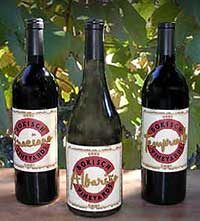 |
Bokisch:
a good Albariño is always
hard to beat |
Although
it's true that the Lodi of today is flush with remarkable reds,
its whites are no slouches. Of particular fascination is the 2002
Bokisch Vineyards Albariño ($16); one of the handful of wines
in the U.S. made from this Spanish grape. The white wines made from
Spanish grown Albariño tend to combine flowery, flinty fragrances
with a citrusy dryness, and Bokisch's
rendition pretty much hits the mark, with the addition of an apricot
pit fruitiness and soft, easy finish. You could say that the best
Albariño is never as full flavored as a Chardonnay, nor as
fruit filled as a Riesling; but in the context of wood smoked oysters,
ceviche, a seafood paella or risotto, a good Albariño is
always hard to beat.
The white wine Lodi has really come to specialize in, however, seems
to be Viognier, the full bodied, exotically scented varietal originating
from France's Northern Rhone Valley. Try these whites with Chinese
style chicken, duck or steamed fish, or else mildly spiced (not
too hot) curries laced with coconut milk, and you're in for a "bam!"
by
Randal Caparoso
| Randal
Caparoso is a well-known multi-award winning wine director
and founding partner of the Roy's restaurant group. He
has recently started his own wine label project called
Caparoso Wines and has written a book called Winning
Boy, and many articles for The
Honolulu Advertiser since 1981. |
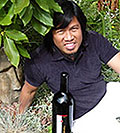 |
|
© Randal Caparoso
|
